Financial Statement Analysis & Valuation Report - ACFI 810, ULMS
VerifiedAdded on 2023/06/18
|12
|2909
|406
Report
AI Summary
This report provides a comprehensive financial statement analysis and valuation, focusing on key financial concepts and their application. It includes a recommended income statement, balance sheet, and free cash flow calculation, along with potential benchmarks for analyzing company performance. The report calculates the value of the firm, bonds, and equity, discussing the advantages and disadvantages of dividend discount analysis. It further explores how financial leverage influences a firm's ROCE and compares initiative, passive, and fundamental investors. Finally, the report differentiates between residual earning and discounted cash flow approaches, providing a thorough overview of financial analysis and valuation techniques. Desklib provides past papers and solved assignments for students.
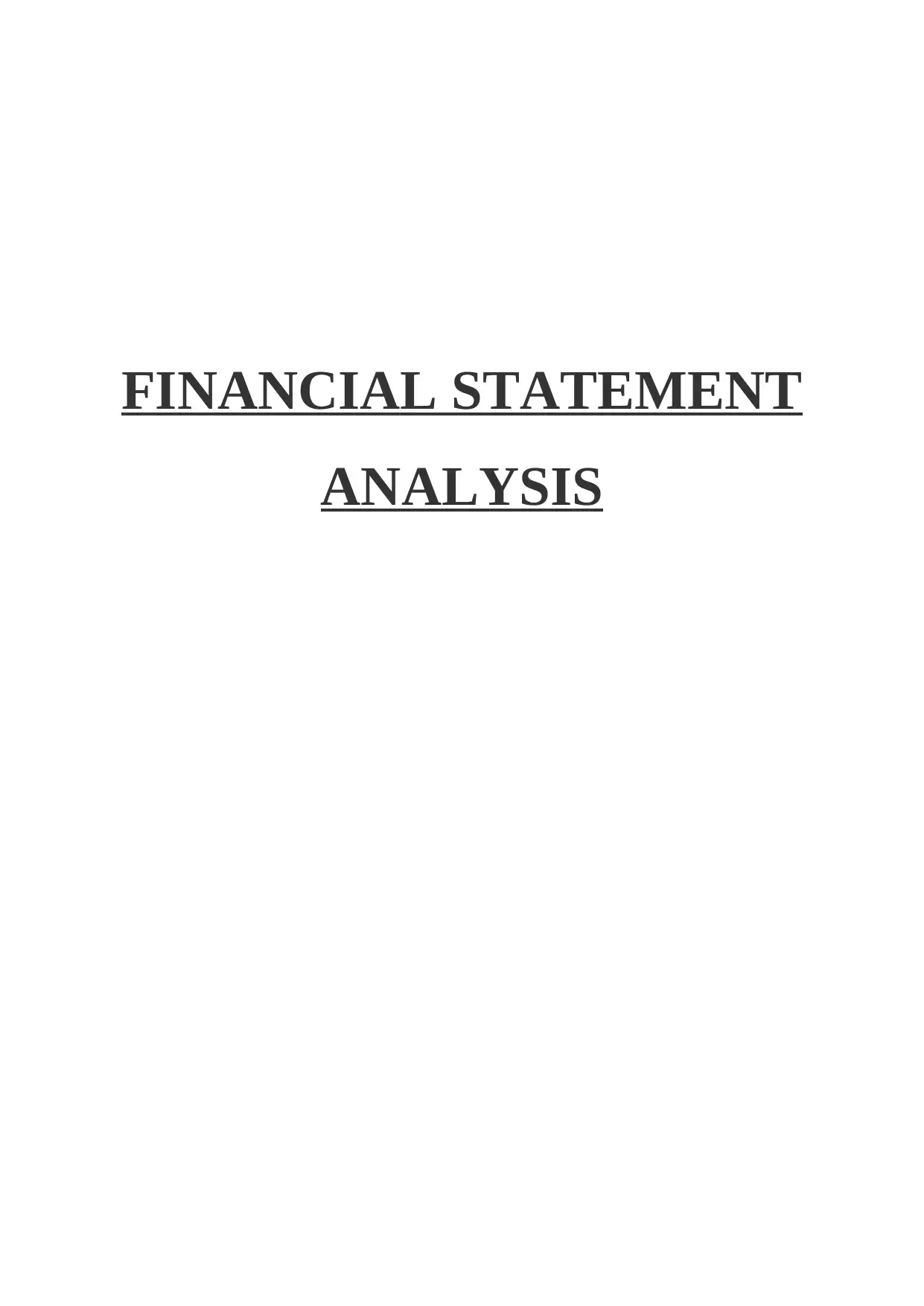
FINANCIAL STATEMENT
ANALYSIS
ANALYSIS
Paraphrase This Document
Need a fresh take? Get an instant paraphrase of this document with our AI Paraphraser
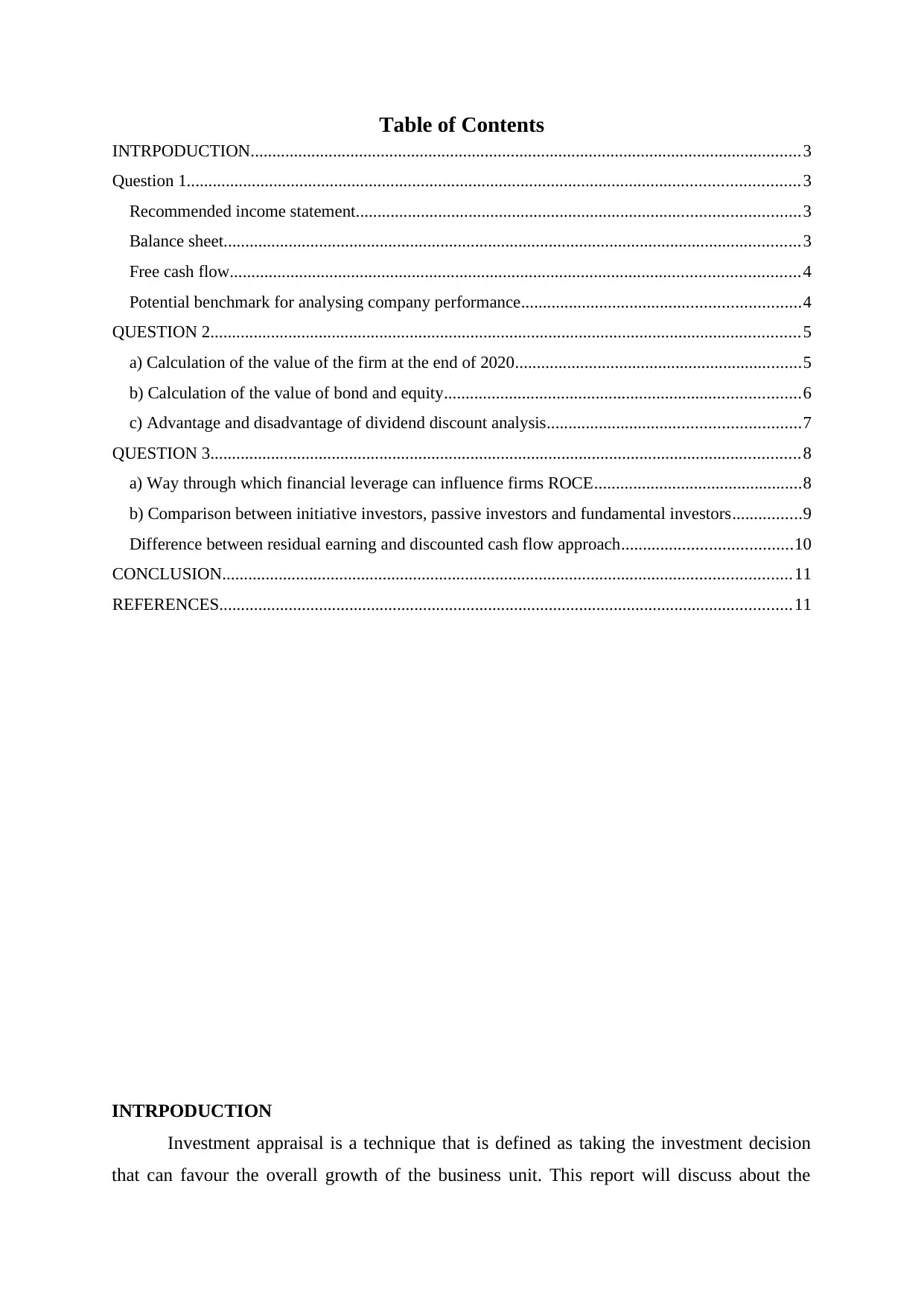
Table of Contents
INTRPODUCTION...............................................................................................................................3
Question 1.............................................................................................................................................3
Recommended income statement......................................................................................................3
Balance sheet.....................................................................................................................................3
Free cash flow...................................................................................................................................4
Potential benchmark for analysing company performance................................................................4
QUESTION 2........................................................................................................................................5
a) Calculation of the value of the firm at the end of 2020..................................................................5
b) Calculation of the value of bond and equity..................................................................................6
c) Advantage and disadvantage of dividend discount analysis..........................................................7
QUESTION 3........................................................................................................................................8
a) Way through which financial leverage can influence firms ROCE................................................8
b) Comparison between initiative investors, passive investors and fundamental investors................9
Difference between residual earning and discounted cash flow approach.......................................10
CONCLUSION...................................................................................................................................11
REFERENCES....................................................................................................................................11
INTRPODUCTION
Investment appraisal is a technique that is defined as taking the investment decision
that can favour the overall growth of the business unit. This report will discuss about the
INTRPODUCTION...............................................................................................................................3
Question 1.............................................................................................................................................3
Recommended income statement......................................................................................................3
Balance sheet.....................................................................................................................................3
Free cash flow...................................................................................................................................4
Potential benchmark for analysing company performance................................................................4
QUESTION 2........................................................................................................................................5
a) Calculation of the value of the firm at the end of 2020..................................................................5
b) Calculation of the value of bond and equity..................................................................................6
c) Advantage and disadvantage of dividend discount analysis..........................................................7
QUESTION 3........................................................................................................................................8
a) Way through which financial leverage can influence firms ROCE................................................8
b) Comparison between initiative investors, passive investors and fundamental investors................9
Difference between residual earning and discounted cash flow approach.......................................10
CONCLUSION...................................................................................................................................11
REFERENCES....................................................................................................................................11
INTRPODUCTION
Investment appraisal is a technique that is defined as taking the investment decision
that can favour the overall growth of the business unit. This report will discuss about the
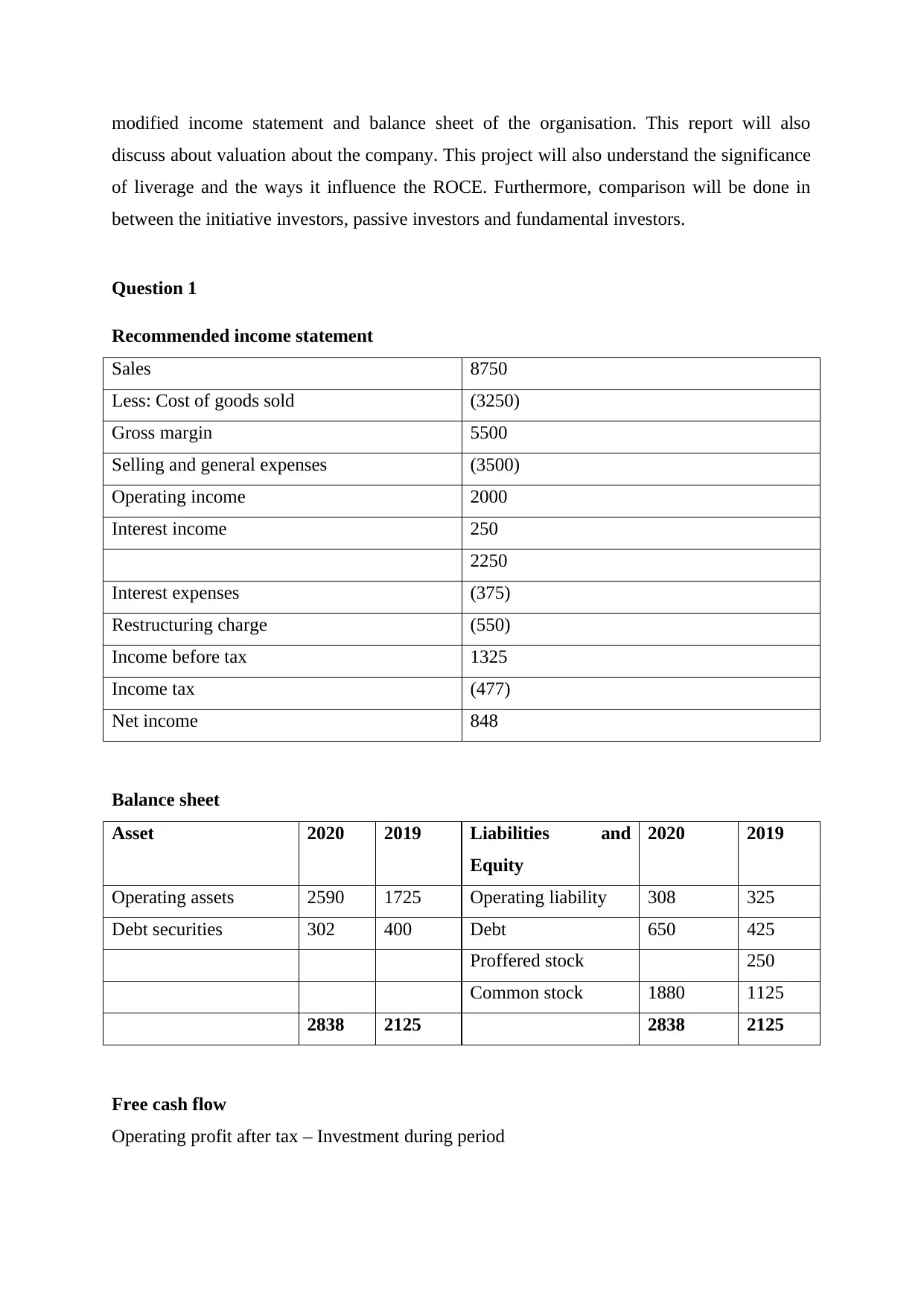
modified income statement and balance sheet of the organisation. This report will also
discuss about valuation about the company. This project will also understand the significance
of liverage and the ways it influence the ROCE. Furthermore, comparison will be done in
between the initiative investors, passive investors and fundamental investors.
Question 1
Recommended income statement
Sales 8750
Less: Cost of goods sold (3250)
Gross margin 5500
Selling and general expenses (3500)
Operating income 2000
Interest income 250
2250
Interest expenses (375)
Restructuring charge (550)
Income before tax 1325
Income tax (477)
Net income 848
Balance sheet
Asset 2020 2019 Liabilities and
Equity
2020 2019
Operating assets 2590 1725 Operating liability 308 325
Debt securities 302 400 Debt 650 425
Proffered stock 250
Common stock 1880 1125
2838 2125 2838 2125
Free cash flow
Operating profit after tax – Investment during period
discuss about valuation about the company. This project will also understand the significance
of liverage and the ways it influence the ROCE. Furthermore, comparison will be done in
between the initiative investors, passive investors and fundamental investors.
Question 1
Recommended income statement
Sales 8750
Less: Cost of goods sold (3250)
Gross margin 5500
Selling and general expenses (3500)
Operating income 2000
Interest income 250
2250
Interest expenses (375)
Restructuring charge (550)
Income before tax 1325
Income tax (477)
Net income 848
Balance sheet
Asset 2020 2019 Liabilities and
Equity
2020 2019
Operating assets 2590 1725 Operating liability 308 325
Debt securities 302 400 Debt 650 425
Proffered stock 250
Common stock 1880 1125
2838 2125 2838 2125
Free cash flow
Operating profit after tax – Investment during period
⊘ This is a preview!⊘
Do you want full access?
Subscribe today to unlock all pages.

Trusted by 1+ million students worldwide
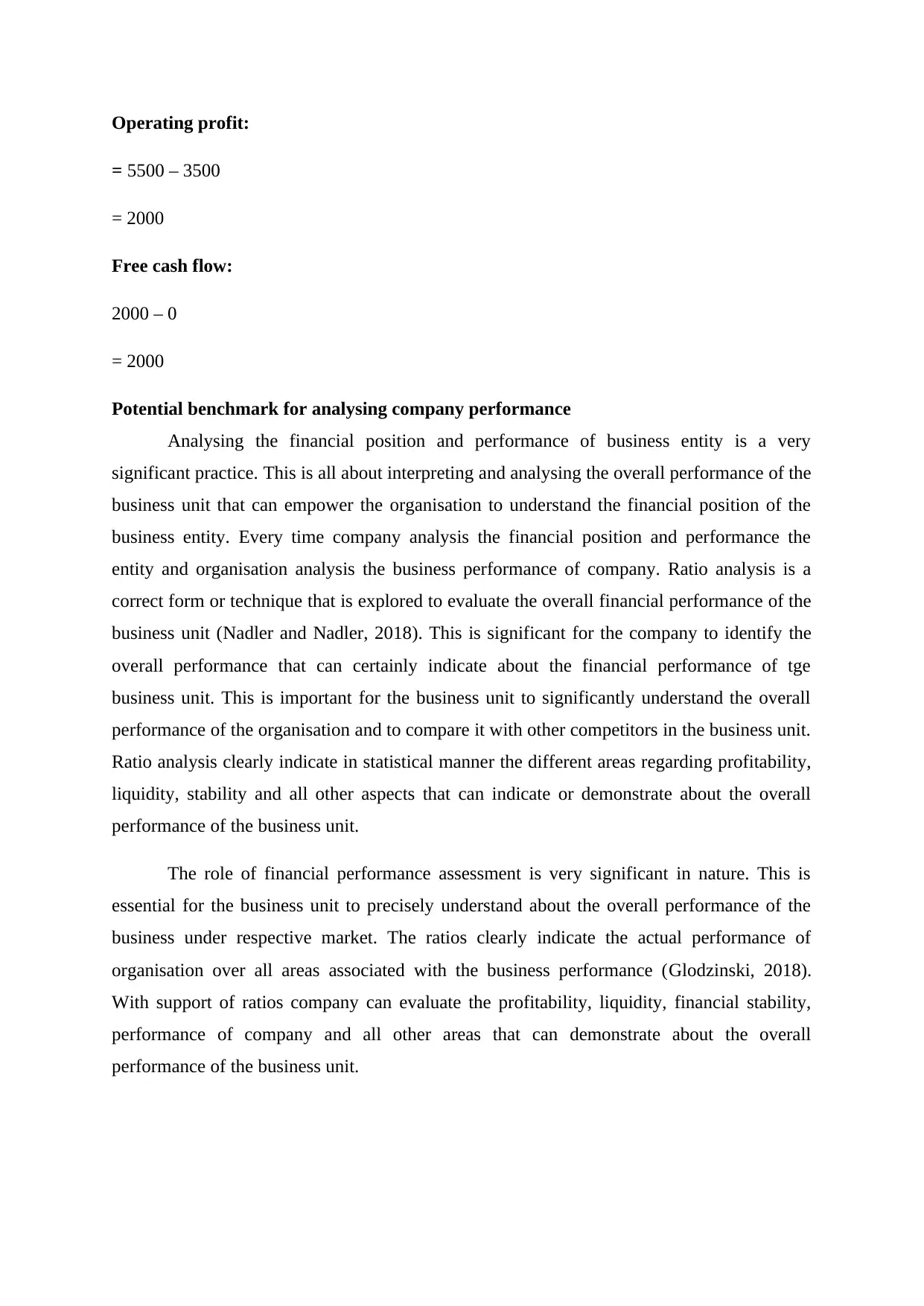
Operating profit:
= 5500 – 3500
= 2000
Free cash flow:
2000 – 0
= 2000
Potential benchmark for analysing company performance
Analysing the financial position and performance of business entity is a very
significant practice. This is all about interpreting and analysing the overall performance of the
business unit that can empower the organisation to understand the financial position of the
business entity. Every time company analysis the financial position and performance the
entity and organisation analysis the business performance of company. Ratio analysis is a
correct form or technique that is explored to evaluate the overall financial performance of the
business unit (Nadler and Nadler, 2018). This is significant for the company to identify the
overall performance that can certainly indicate about the financial performance of tge
business unit. This is important for the business unit to significantly understand the overall
performance of the organisation and to compare it with other competitors in the business unit.
Ratio analysis clearly indicate in statistical manner the different areas regarding profitability,
liquidity, stability and all other aspects that can indicate or demonstrate about the overall
performance of the business unit.
The role of financial performance assessment is very significant in nature. This is
essential for the business unit to precisely understand about the overall performance of the
business under respective market. The ratios clearly indicate the actual performance of
organisation over all areas associated with the business performance (Glodzinski, 2018).
With support of ratios company can evaluate the profitability, liquidity, financial stability,
performance of company and all other areas that can demonstrate about the overall
performance of the business unit.
= 5500 – 3500
= 2000
Free cash flow:
2000 – 0
= 2000
Potential benchmark for analysing company performance
Analysing the financial position and performance of business entity is a very
significant practice. This is all about interpreting and analysing the overall performance of the
business unit that can empower the organisation to understand the financial position of the
business entity. Every time company analysis the financial position and performance the
entity and organisation analysis the business performance of company. Ratio analysis is a
correct form or technique that is explored to evaluate the overall financial performance of the
business unit (Nadler and Nadler, 2018). This is significant for the company to identify the
overall performance that can certainly indicate about the financial performance of tge
business unit. This is important for the business unit to significantly understand the overall
performance of the organisation and to compare it with other competitors in the business unit.
Ratio analysis clearly indicate in statistical manner the different areas regarding profitability,
liquidity, stability and all other aspects that can indicate or demonstrate about the overall
performance of the business unit.
The role of financial performance assessment is very significant in nature. This is
essential for the business unit to precisely understand about the overall performance of the
business under respective market. The ratios clearly indicate the actual performance of
organisation over all areas associated with the business performance (Glodzinski, 2018).
With support of ratios company can evaluate the profitability, liquidity, financial stability,
performance of company and all other areas that can demonstrate about the overall
performance of the business unit.
Paraphrase This Document
Need a fresh take? Get an instant paraphrase of this document with our AI Paraphraser
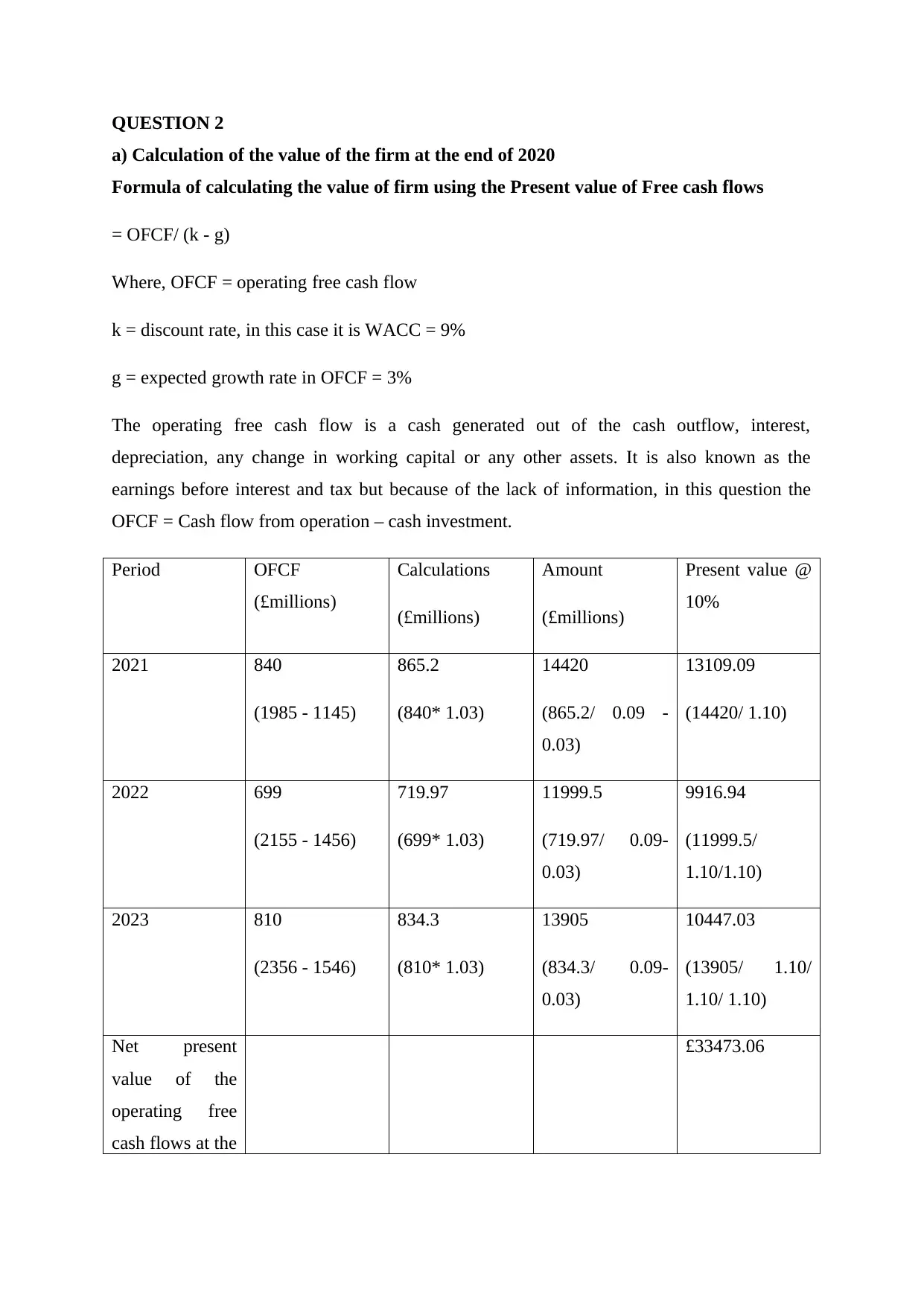
QUESTION 2
a) Calculation of the value of the firm at the end of 2020
Formula of calculating the value of firm using the Present value of Free cash flows
= OFCF/ (k - g)
Where, OFCF = operating free cash flow
k = discount rate, in this case it is WACC = 9%
g = expected growth rate in OFCF = 3%
The operating free cash flow is a cash generated out of the cash outflow, interest,
depreciation, any change in working capital or any other assets. It is also known as the
earnings before interest and tax but because of the lack of information, in this question the
OFCF = Cash flow from operation – cash investment.
Period OFCF
(£millions)
Calculations
(£millions)
Amount
(£millions)
Present value @
10%
2021 840
(1985 - 1145)
865.2
(840* 1.03)
14420
(865.2/ 0.09 -
0.03)
13109.09
(14420/ 1.10)
2022 699
(2155 - 1456)
719.97
(699* 1.03)
11999.5
(719.97/ 0.09-
0.03)
9916.94
(11999.5/
1.10/1.10)
2023 810
(2356 - 1546)
834.3
(810* 1.03)
13905
(834.3/ 0.09-
0.03)
10447.03
(13905/ 1.10/
1.10/ 1.10)
Net present
value of the
operating free
cash flows at the
£33473.06
a) Calculation of the value of the firm at the end of 2020
Formula of calculating the value of firm using the Present value of Free cash flows
= OFCF/ (k - g)
Where, OFCF = operating free cash flow
k = discount rate, in this case it is WACC = 9%
g = expected growth rate in OFCF = 3%
The operating free cash flow is a cash generated out of the cash outflow, interest,
depreciation, any change in working capital or any other assets. It is also known as the
earnings before interest and tax but because of the lack of information, in this question the
OFCF = Cash flow from operation – cash investment.
Period OFCF
(£millions)
Calculations
(£millions)
Amount
(£millions)
Present value @
10%
2021 840
(1985 - 1145)
865.2
(840* 1.03)
14420
(865.2/ 0.09 -
0.03)
13109.09
(14420/ 1.10)
2022 699
(2155 - 1456)
719.97
(699* 1.03)
11999.5
(719.97/ 0.09-
0.03)
9916.94
(11999.5/
1.10/1.10)
2023 810
(2356 - 1546)
834.3
(810* 1.03)
13905
(834.3/ 0.09-
0.03)
10447.03
(13905/ 1.10/
1.10/ 1.10)
Net present
value of the
operating free
cash flows at the
£33473.06
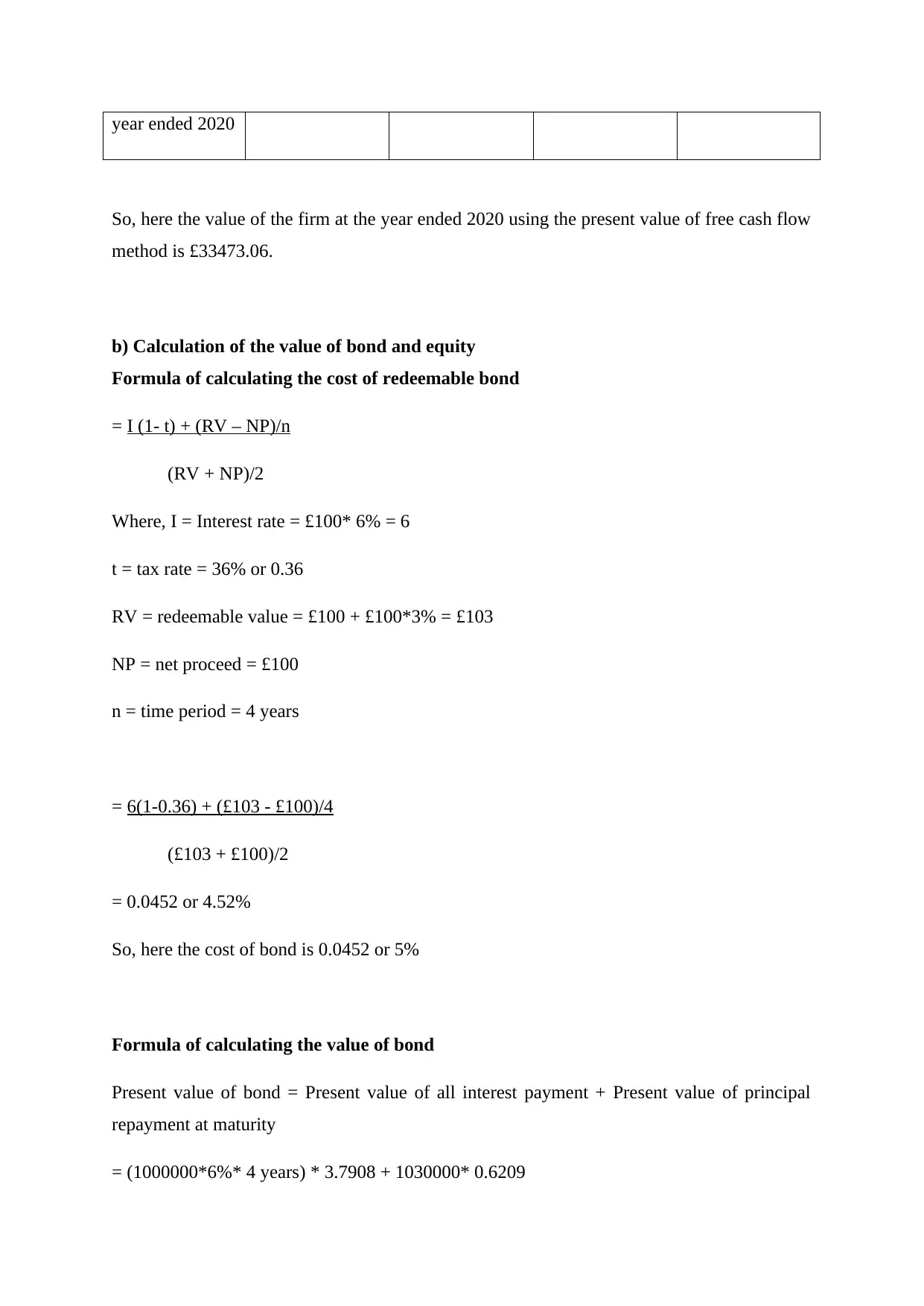
year ended 2020
So, here the value of the firm at the year ended 2020 using the present value of free cash flow
method is £33473.06.
b) Calculation of the value of bond and equity
Formula of calculating the cost of redeemable bond
= I (1- t) + (RV – NP)/n
(RV + NP)/2
Where, I = Interest rate = £100* 6% = 6
t = tax rate = 36% or 0.36
RV = redeemable value = £100 + £100*3% = £103
NP = net proceed = £100
n = time period = 4 years
= 6(1-0.36) + (£103 - £100)/4
(£103 + £100)/2
= 0.0452 or 4.52%
So, here the cost of bond is 0.0452 or 5%
Formula of calculating the value of bond
Present value of bond = Present value of all interest payment + Present value of principal
repayment at maturity
= (1000000*6%* 4 years) * 3.7908 + 1030000* 0.6209
So, here the value of the firm at the year ended 2020 using the present value of free cash flow
method is £33473.06.
b) Calculation of the value of bond and equity
Formula of calculating the cost of redeemable bond
= I (1- t) + (RV – NP)/n
(RV + NP)/2
Where, I = Interest rate = £100* 6% = 6
t = tax rate = 36% or 0.36
RV = redeemable value = £100 + £100*3% = £103
NP = net proceed = £100
n = time period = 4 years
= 6(1-0.36) + (£103 - £100)/4
(£103 + £100)/2
= 0.0452 or 4.52%
So, here the cost of bond is 0.0452 or 5%
Formula of calculating the value of bond
Present value of bond = Present value of all interest payment + Present value of principal
repayment at maturity
= (1000000*6%* 4 years) * 3.7908 + 1030000* 0.6209
⊘ This is a preview!⊘
Do you want full access?
Subscribe today to unlock all pages.

Trusted by 1+ million students worldwide
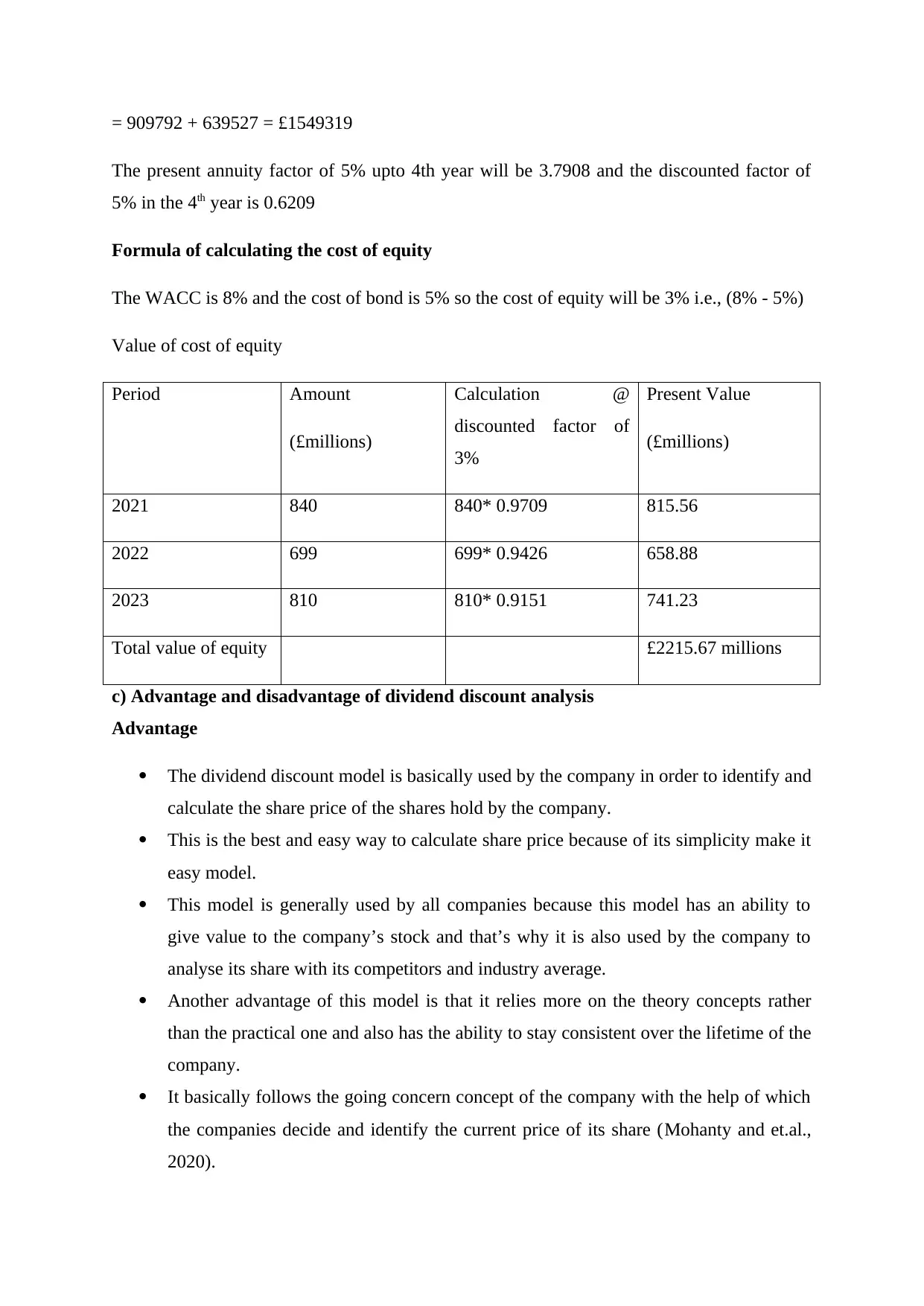
= 909792 + 639527 = £1549319
The present annuity factor of 5% upto 4th year will be 3.7908 and the discounted factor of
5% in the 4th year is 0.6209
Formula of calculating the cost of equity
The WACC is 8% and the cost of bond is 5% so the cost of equity will be 3% i.e., (8% - 5%)
Value of cost of equity
Period Amount
(£millions)
Calculation @
discounted factor of
3%
Present Value
(£millions)
2021 840 840* 0.9709 815.56
2022 699 699* 0.9426 658.88
2023 810 810* 0.9151 741.23
Total value of equity £2215.67 millions
c) Advantage and disadvantage of dividend discount analysis
Advantage
The dividend discount model is basically used by the company in order to identify and
calculate the share price of the shares hold by the company.
This is the best and easy way to calculate share price because of its simplicity make it
easy model.
This model is generally used by all companies because this model has an ability to
give value to the company’s stock and that’s why it is also used by the company to
analyse its share with its competitors and industry average.
Another advantage of this model is that it relies more on the theory concepts rather
than the practical one and also has the ability to stay consistent over the lifetime of the
company.
It basically follows the going concern concept of the company with the help of which
the companies decide and identify the current price of its share (Mohanty and et.al.,
2020).
The present annuity factor of 5% upto 4th year will be 3.7908 and the discounted factor of
5% in the 4th year is 0.6209
Formula of calculating the cost of equity
The WACC is 8% and the cost of bond is 5% so the cost of equity will be 3% i.e., (8% - 5%)
Value of cost of equity
Period Amount
(£millions)
Calculation @
discounted factor of
3%
Present Value
(£millions)
2021 840 840* 0.9709 815.56
2022 699 699* 0.9426 658.88
2023 810 810* 0.9151 741.23
Total value of equity £2215.67 millions
c) Advantage and disadvantage of dividend discount analysis
Advantage
The dividend discount model is basically used by the company in order to identify and
calculate the share price of the shares hold by the company.
This is the best and easy way to calculate share price because of its simplicity make it
easy model.
This model is generally used by all companies because this model has an ability to
give value to the company’s stock and that’s why it is also used by the company to
analyse its share with its competitors and industry average.
Another advantage of this model is that it relies more on the theory concepts rather
than the practical one and also has the ability to stay consistent over the lifetime of the
company.
It basically follows the going concern concept of the company with the help of which
the companies decide and identify the current price of its share (Mohanty and et.al.,
2020).
Paraphrase This Document
Need a fresh take? Get an instant paraphrase of this document with our AI Paraphraser
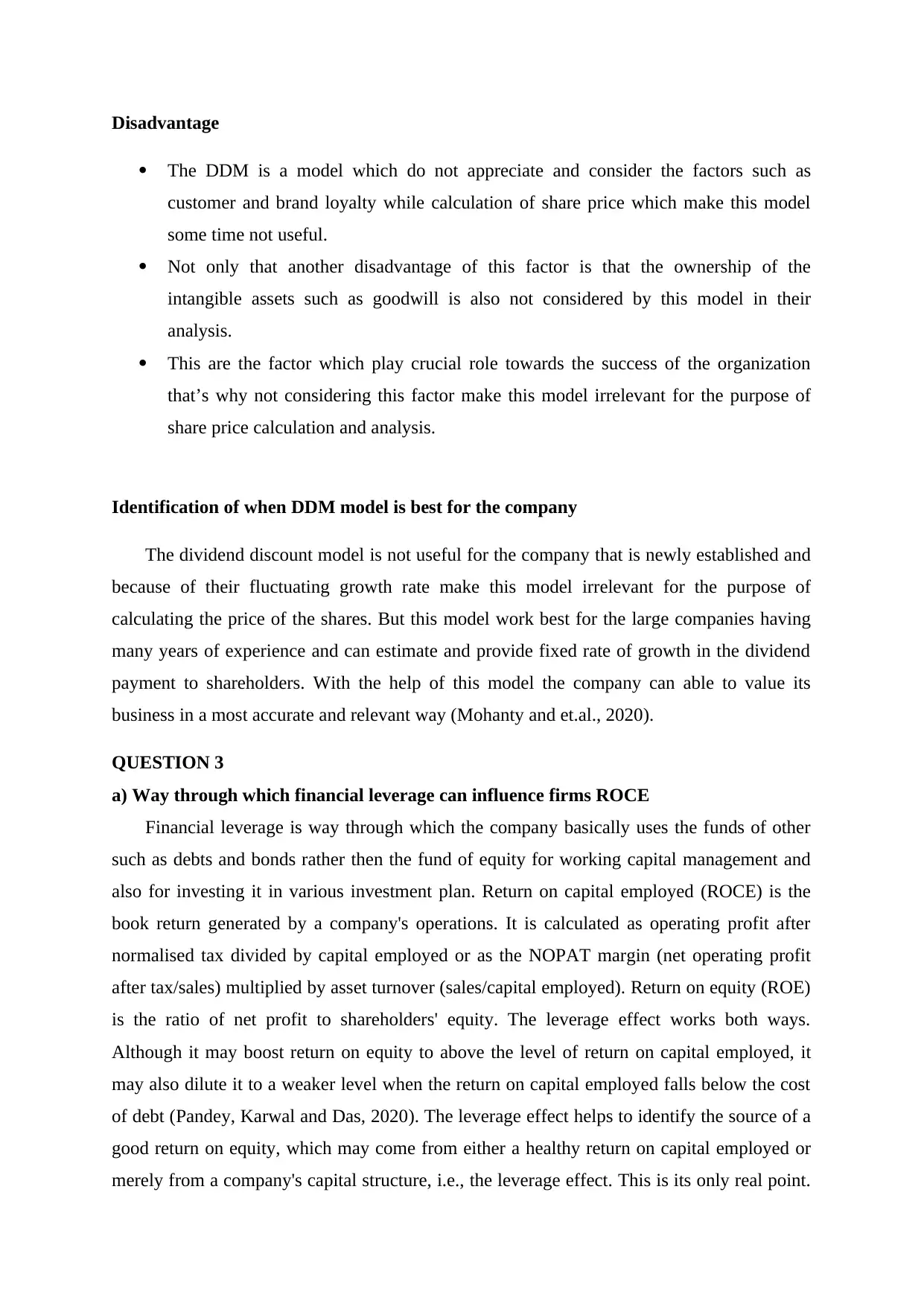
Disadvantage
The DDM is a model which do not appreciate and consider the factors such as
customer and brand loyalty while calculation of share price which make this model
some time not useful.
Not only that another disadvantage of this factor is that the ownership of the
intangible assets such as goodwill is also not considered by this model in their
analysis.
This are the factor which play crucial role towards the success of the organization
that’s why not considering this factor make this model irrelevant for the purpose of
share price calculation and analysis.
Identification of when DDM model is best for the company
The dividend discount model is not useful for the company that is newly established and
because of their fluctuating growth rate make this model irrelevant for the purpose of
calculating the price of the shares. But this model work best for the large companies having
many years of experience and can estimate and provide fixed rate of growth in the dividend
payment to shareholders. With the help of this model the company can able to value its
business in a most accurate and relevant way (Mohanty and et.al., 2020).
QUESTION 3
a) Way through which financial leverage can influence firms ROCE
Financial leverage is way through which the company basically uses the funds of other
such as debts and bonds rather then the fund of equity for working capital management and
also for investing it in various investment plan. Return on capital employed (ROCE) is the
book return generated by a company's operations. It is calculated as operating profit after
normalised tax divided by capital employed or as the NOPAT margin (net operating profit
after tax/sales) multiplied by asset turnover (sales/capital employed). Return on equity (ROE)
is the ratio of net profit to shareholders' equity. The leverage effect works both ways.
Although it may boost return on equity to above the level of return on capital employed, it
may also dilute it to a weaker level when the return on capital employed falls below the cost
of debt (Pandey, Karwal and Das, 2020). The leverage effect helps to identify the source of a
good return on equity, which may come from either a healthy return on capital employed or
merely from a company's capital structure, i.e., the leverage effect. This is its only real point.
The DDM is a model which do not appreciate and consider the factors such as
customer and brand loyalty while calculation of share price which make this model
some time not useful.
Not only that another disadvantage of this factor is that the ownership of the
intangible assets such as goodwill is also not considered by this model in their
analysis.
This are the factor which play crucial role towards the success of the organization
that’s why not considering this factor make this model irrelevant for the purpose of
share price calculation and analysis.
Identification of when DDM model is best for the company
The dividend discount model is not useful for the company that is newly established and
because of their fluctuating growth rate make this model irrelevant for the purpose of
calculating the price of the shares. But this model work best for the large companies having
many years of experience and can estimate and provide fixed rate of growth in the dividend
payment to shareholders. With the help of this model the company can able to value its
business in a most accurate and relevant way (Mohanty and et.al., 2020).
QUESTION 3
a) Way through which financial leverage can influence firms ROCE
Financial leverage is way through which the company basically uses the funds of other
such as debts and bonds rather then the fund of equity for working capital management and
also for investing it in various investment plan. Return on capital employed (ROCE) is the
book return generated by a company's operations. It is calculated as operating profit after
normalised tax divided by capital employed or as the NOPAT margin (net operating profit
after tax/sales) multiplied by asset turnover (sales/capital employed). Return on equity (ROE)
is the ratio of net profit to shareholders' equity. The leverage effect works both ways.
Although it may boost return on equity to above the level of return on capital employed, it
may also dilute it to a weaker level when the return on capital employed falls below the cost
of debt (Pandey, Karwal and Das, 2020). The leverage effect helps to identify the source of a
good return on equity, which may come from either a healthy return on capital employed or
merely from a company's capital structure, i.e., the leverage effect. This is its only real point.
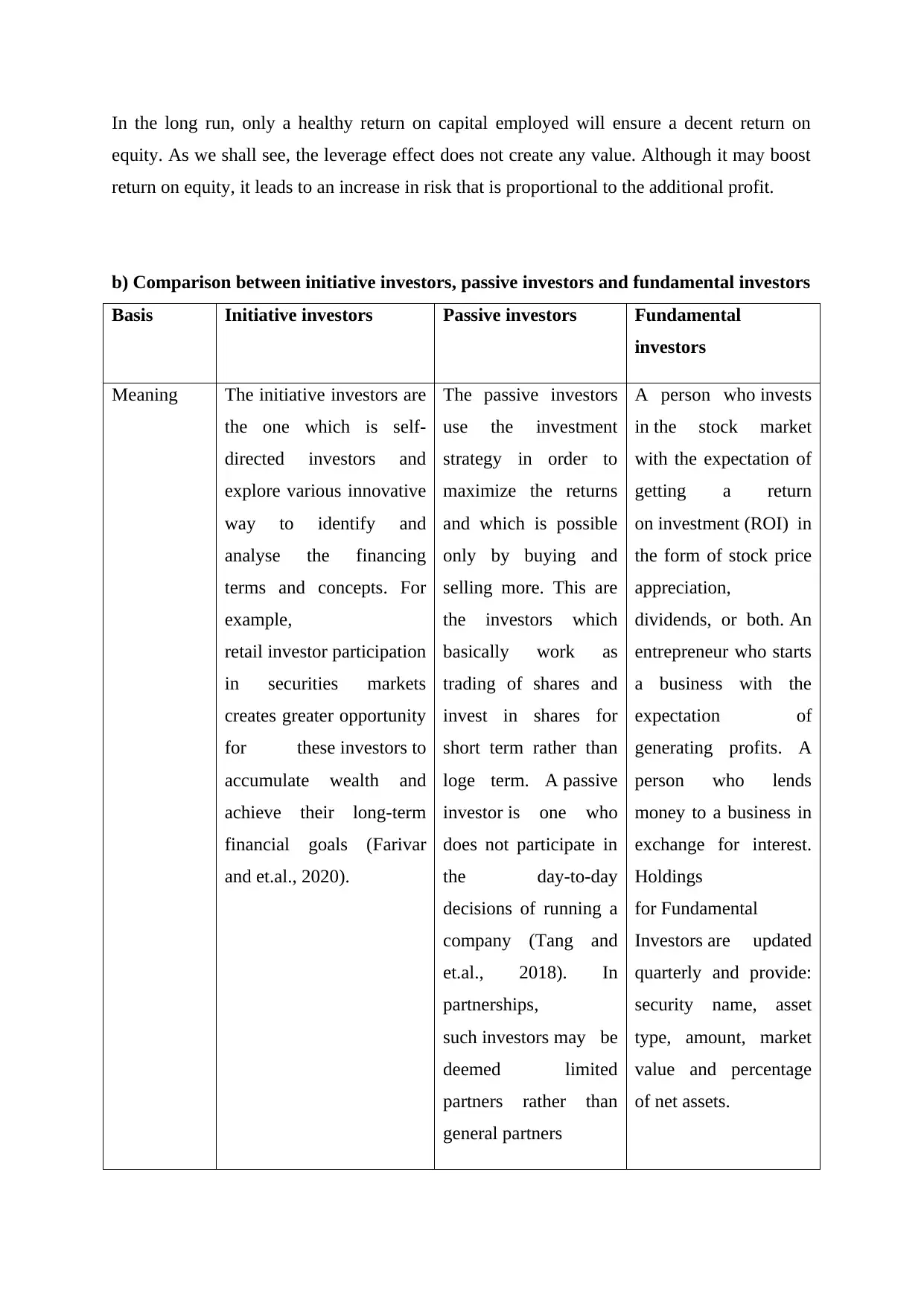
In the long run, only a healthy return on capital employed will ensure a decent return on
equity. As we shall see, the leverage effect does not create any value. Although it may boost
return on equity, it leads to an increase in risk that is proportional to the additional profit.
b) Comparison between initiative investors, passive investors and fundamental investors
Basis Initiative investors Passive investors Fundamental
investors
Meaning The initiative investors are
the one which is self-
directed investors and
explore various innovative
way to identify and
analyse the financing
terms and concepts. For
example,
retail investor participation
in securities markets
creates greater opportunity
for these investors to
accumulate wealth and
achieve their long-term
financial goals (Farivar
and et.al., 2020).
The passive investors
use the investment
strategy in order to
maximize the returns
and which is possible
only by buying and
selling more. This are
the investors which
basically work as
trading of shares and
invest in shares for
short term rather than
loge term. A passive
investor is one who
does not participate in
the day-to-day
decisions of running a
company (Tang and
et.al., 2018). In
partnerships,
such investors may be
deemed limited
partners rather than
general partners
A person who invests
in the stock market
with the expectation of
getting a return
on investment (ROI) in
the form of stock price
appreciation,
dividends, or both. An
entrepreneur who starts
a business with the
expectation of
generating profits. A
person who lends
money to a business in
exchange for interest.
Holdings
for Fundamental
Investors are updated
quarterly and provide:
security name, asset
type, amount, market
value and percentage
of net assets.
equity. As we shall see, the leverage effect does not create any value. Although it may boost
return on equity, it leads to an increase in risk that is proportional to the additional profit.
b) Comparison between initiative investors, passive investors and fundamental investors
Basis Initiative investors Passive investors Fundamental
investors
Meaning The initiative investors are
the one which is self-
directed investors and
explore various innovative
way to identify and
analyse the financing
terms and concepts. For
example,
retail investor participation
in securities markets
creates greater opportunity
for these investors to
accumulate wealth and
achieve their long-term
financial goals (Farivar
and et.al., 2020).
The passive investors
use the investment
strategy in order to
maximize the returns
and which is possible
only by buying and
selling more. This are
the investors which
basically work as
trading of shares and
invest in shares for
short term rather than
loge term. A passive
investor is one who
does not participate in
the day-to-day
decisions of running a
company (Tang and
et.al., 2018). In
partnerships,
such investors may be
deemed limited
partners rather than
general partners
A person who invests
in the stock market
with the expectation of
getting a return
on investment (ROI) in
the form of stock price
appreciation,
dividends, or both. An
entrepreneur who starts
a business with the
expectation of
generating profits. A
person who lends
money to a business in
exchange for interest.
Holdings
for Fundamental
Investors are updated
quarterly and provide:
security name, asset
type, amount, market
value and percentage
of net assets.
⊘ This is a preview!⊘
Do you want full access?
Subscribe today to unlock all pages.

Trusted by 1+ million students worldwide
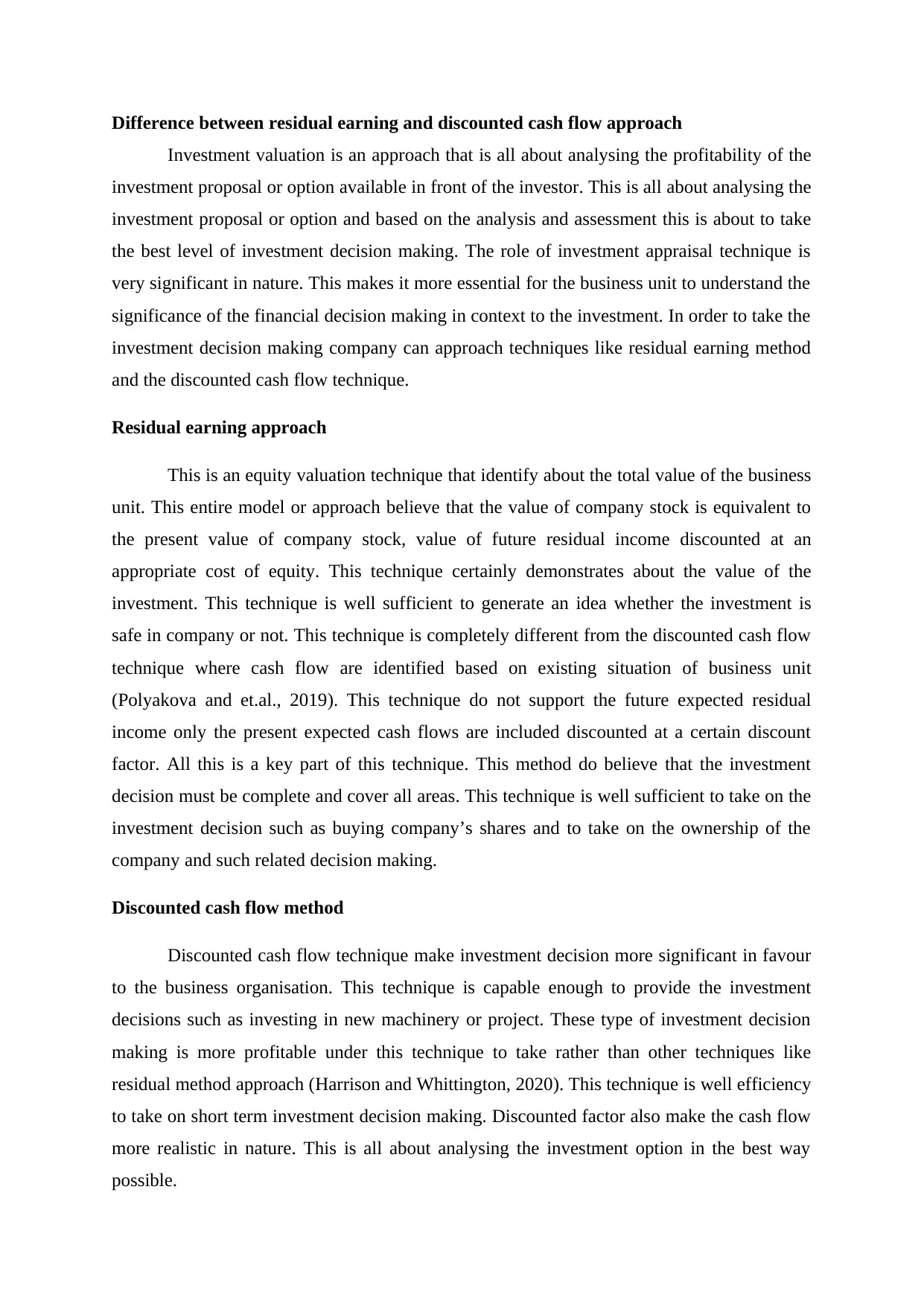
Difference between residual earning and discounted cash flow approach
Investment valuation is an approach that is all about analysing the profitability of the
investment proposal or option available in front of the investor. This is all about analysing the
investment proposal or option and based on the analysis and assessment this is about to take
the best level of investment decision making. The role of investment appraisal technique is
very significant in nature. This makes it more essential for the business unit to understand the
significance of the financial decision making in context to the investment. In order to take the
investment decision making company can approach techniques like residual earning method
and the discounted cash flow technique.
Residual earning approach
This is an equity valuation technique that identify about the total value of the business
unit. This entire model or approach believe that the value of company stock is equivalent to
the present value of company stock, value of future residual income discounted at an
appropriate cost of equity. This technique certainly demonstrates about the value of the
investment. This technique is well sufficient to generate an idea whether the investment is
safe in company or not. This technique is completely different from the discounted cash flow
technique where cash flow are identified based on existing situation of business unit
(Polyakova and et.al., 2019). This technique do not support the future expected residual
income only the present expected cash flows are included discounted at a certain discount
factor. All this is a key part of this technique. This method do believe that the investment
decision must be complete and cover all areas. This technique is well sufficient to take on the
investment decision such as buying company’s shares and to take on the ownership of the
company and such related decision making.
Discounted cash flow method
Discounted cash flow technique make investment decision more significant in favour
to the business organisation. This technique is capable enough to provide the investment
decisions such as investing in new machinery or project. These type of investment decision
making is more profitable under this technique to take rather than other techniques like
residual method approach (Harrison and Whittington, 2020). This technique is well efficiency
to take on short term investment decision making. Discounted factor also make the cash flow
more realistic in nature. This is all about analysing the investment option in the best way
possible.
Investment valuation is an approach that is all about analysing the profitability of the
investment proposal or option available in front of the investor. This is all about analysing the
investment proposal or option and based on the analysis and assessment this is about to take
the best level of investment decision making. The role of investment appraisal technique is
very significant in nature. This makes it more essential for the business unit to understand the
significance of the financial decision making in context to the investment. In order to take the
investment decision making company can approach techniques like residual earning method
and the discounted cash flow technique.
Residual earning approach
This is an equity valuation technique that identify about the total value of the business
unit. This entire model or approach believe that the value of company stock is equivalent to
the present value of company stock, value of future residual income discounted at an
appropriate cost of equity. This technique certainly demonstrates about the value of the
investment. This technique is well sufficient to generate an idea whether the investment is
safe in company or not. This technique is completely different from the discounted cash flow
technique where cash flow are identified based on existing situation of business unit
(Polyakova and et.al., 2019). This technique do not support the future expected residual
income only the present expected cash flows are included discounted at a certain discount
factor. All this is a key part of this technique. This method do believe that the investment
decision must be complete and cover all areas. This technique is well sufficient to take on the
investment decision such as buying company’s shares and to take on the ownership of the
company and such related decision making.
Discounted cash flow method
Discounted cash flow technique make investment decision more significant in favour
to the business organisation. This technique is capable enough to provide the investment
decisions such as investing in new machinery or project. These type of investment decision
making is more profitable under this technique to take rather than other techniques like
residual method approach (Harrison and Whittington, 2020). This technique is well efficiency
to take on short term investment decision making. Discounted factor also make the cash flow
more realistic in nature. This is all about analysing the investment option in the best way
possible.
Paraphrase This Document
Need a fresh take? Get an instant paraphrase of this document with our AI Paraphraser
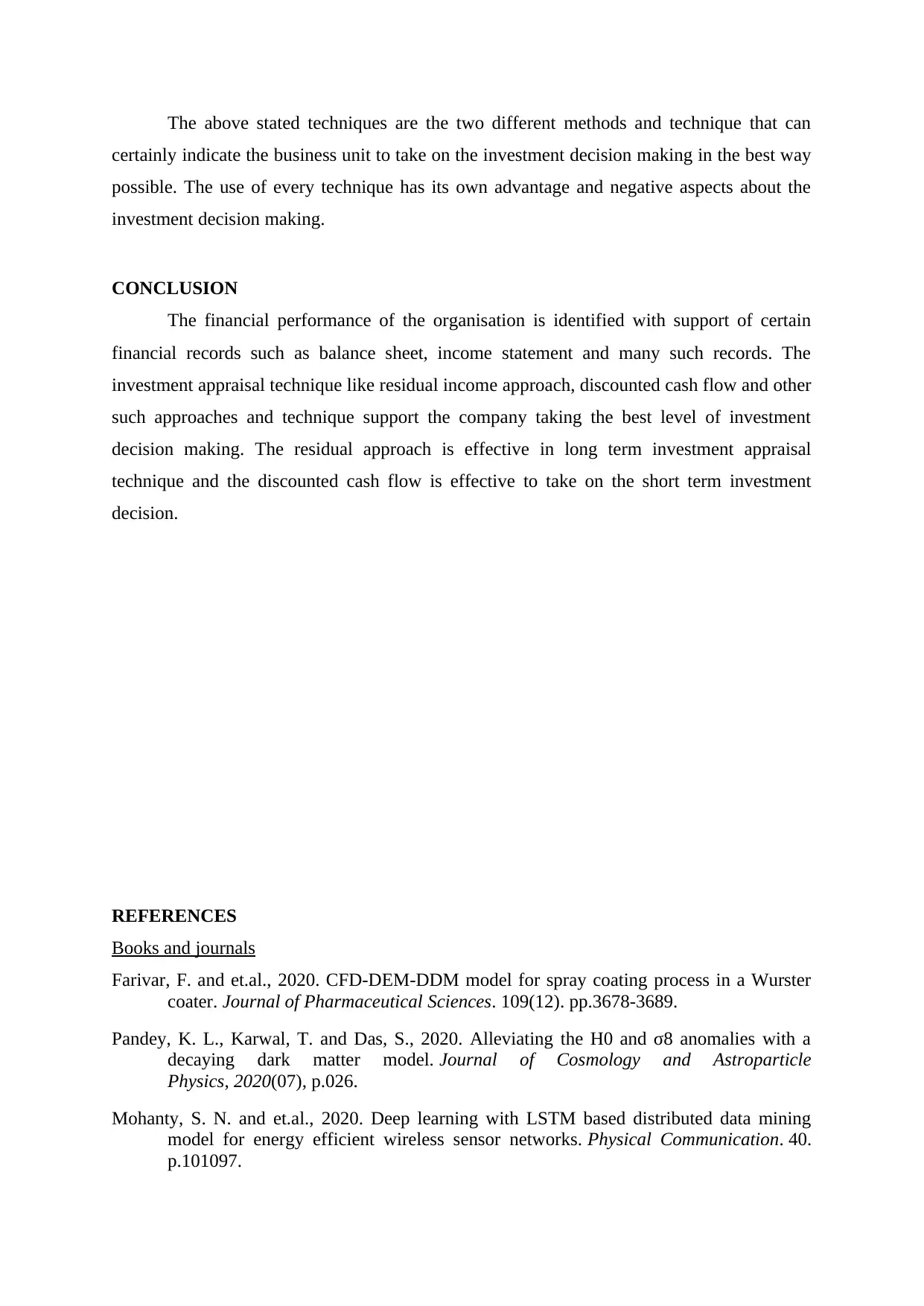
The above stated techniques are the two different methods and technique that can
certainly indicate the business unit to take on the investment decision making in the best way
possible. The use of every technique has its own advantage and negative aspects about the
investment decision making.
CONCLUSION
The financial performance of the organisation is identified with support of certain
financial records such as balance sheet, income statement and many such records. The
investment appraisal technique like residual income approach, discounted cash flow and other
such approaches and technique support the company taking the best level of investment
decision making. The residual approach is effective in long term investment appraisal
technique and the discounted cash flow is effective to take on the short term investment
decision.
REFERENCES
Books and journals
Farivar, F. and et.al., 2020. CFD-DEM-DDM model for spray coating process in a Wurster
coater. Journal of Pharmaceutical Sciences. 109(12). pp.3678-3689.
Pandey, K. L., Karwal, T. and Das, S., 2020. Alleviating the H0 and σ8 anomalies with a
decaying dark matter model. Journal of Cosmology and Astroparticle
Physics, 2020(07), p.026.
Mohanty, S. N. and et.al., 2020. Deep learning with LSTM based distributed data mining
model for energy efficient wireless sensor networks. Physical Communication. 40.
p.101097.
certainly indicate the business unit to take on the investment decision making in the best way
possible. The use of every technique has its own advantage and negative aspects about the
investment decision making.
CONCLUSION
The financial performance of the organisation is identified with support of certain
financial records such as balance sheet, income statement and many such records. The
investment appraisal technique like residual income approach, discounted cash flow and other
such approaches and technique support the company taking the best level of investment
decision making. The residual approach is effective in long term investment appraisal
technique and the discounted cash flow is effective to take on the short term investment
decision.
REFERENCES
Books and journals
Farivar, F. and et.al., 2020. CFD-DEM-DDM model for spray coating process in a Wurster
coater. Journal of Pharmaceutical Sciences. 109(12). pp.3678-3689.
Pandey, K. L., Karwal, T. and Das, S., 2020. Alleviating the H0 and σ8 anomalies with a
decaying dark matter model. Journal of Cosmology and Astroparticle
Physics, 2020(07), p.026.
Mohanty, S. N. and et.al., 2020. Deep learning with LSTM based distributed data mining
model for energy efficient wireless sensor networks. Physical Communication. 40.
p.101097.
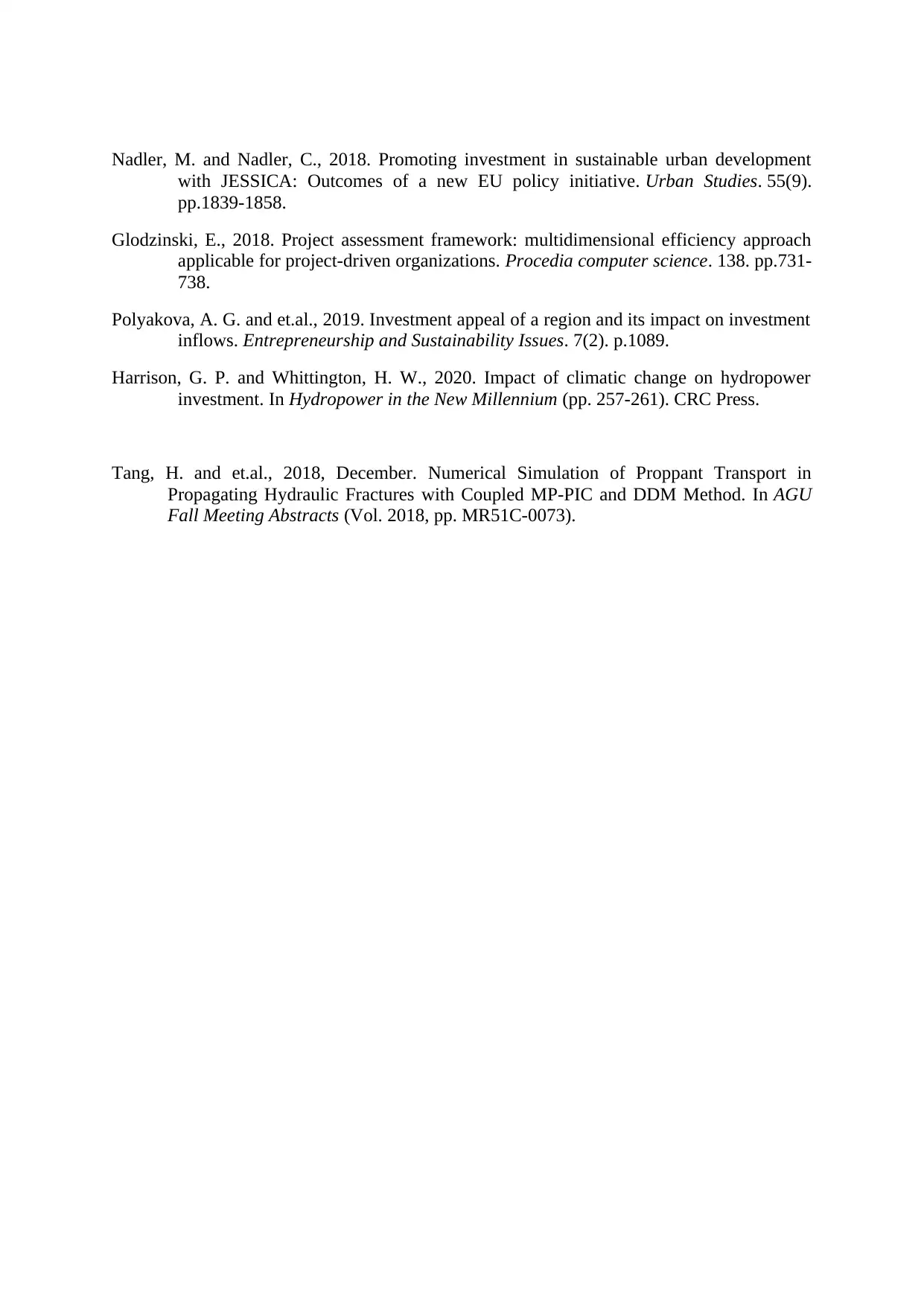
Nadler, M. and Nadler, C., 2018. Promoting investment in sustainable urban development
with JESSICA: Outcomes of a new EU policy initiative. Urban Studies. 55(9).
pp.1839-1858.
Glodzinski, E., 2018. Project assessment framework: multidimensional efficiency approach
applicable for project-driven organizations. Procedia computer science. 138. pp.731-
738.
Polyakova, A. G. and et.al., 2019. Investment appeal of a region and its impact on investment
inflows. Entrepreneurship and Sustainability Issues. 7(2). p.1089.
Harrison, G. P. and Whittington, H. W., 2020. Impact of climatic change on hydropower
investment. In Hydropower in the New Millennium (pp. 257-261). CRC Press.
Tang, H. and et.al., 2018, December. Numerical Simulation of Proppant Transport in
Propagating Hydraulic Fractures with Coupled MP-PIC and DDM Method. In AGU
Fall Meeting Abstracts (Vol. 2018, pp. MR51C-0073).
with JESSICA: Outcomes of a new EU policy initiative. Urban Studies. 55(9).
pp.1839-1858.
Glodzinski, E., 2018. Project assessment framework: multidimensional efficiency approach
applicable for project-driven organizations. Procedia computer science. 138. pp.731-
738.
Polyakova, A. G. and et.al., 2019. Investment appeal of a region and its impact on investment
inflows. Entrepreneurship and Sustainability Issues. 7(2). p.1089.
Harrison, G. P. and Whittington, H. W., 2020. Impact of climatic change on hydropower
investment. In Hydropower in the New Millennium (pp. 257-261). CRC Press.
Tang, H. and et.al., 2018, December. Numerical Simulation of Proppant Transport in
Propagating Hydraulic Fractures with Coupled MP-PIC and DDM Method. In AGU
Fall Meeting Abstracts (Vol. 2018, pp. MR51C-0073).
⊘ This is a preview!⊘
Do you want full access?
Subscribe today to unlock all pages.

Trusted by 1+ million students worldwide
1 out of 12
Related Documents
Your All-in-One AI-Powered Toolkit for Academic Success.
+13062052269
info@desklib.com
Available 24*7 on WhatsApp / Email
![[object Object]](/_next/static/media/star-bottom.7253800d.svg)
Unlock your academic potential
Copyright © 2020–2025 A2Z Services. All Rights Reserved. Developed and managed by ZUCOL.





